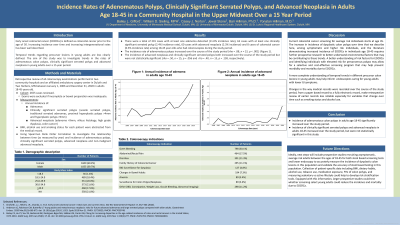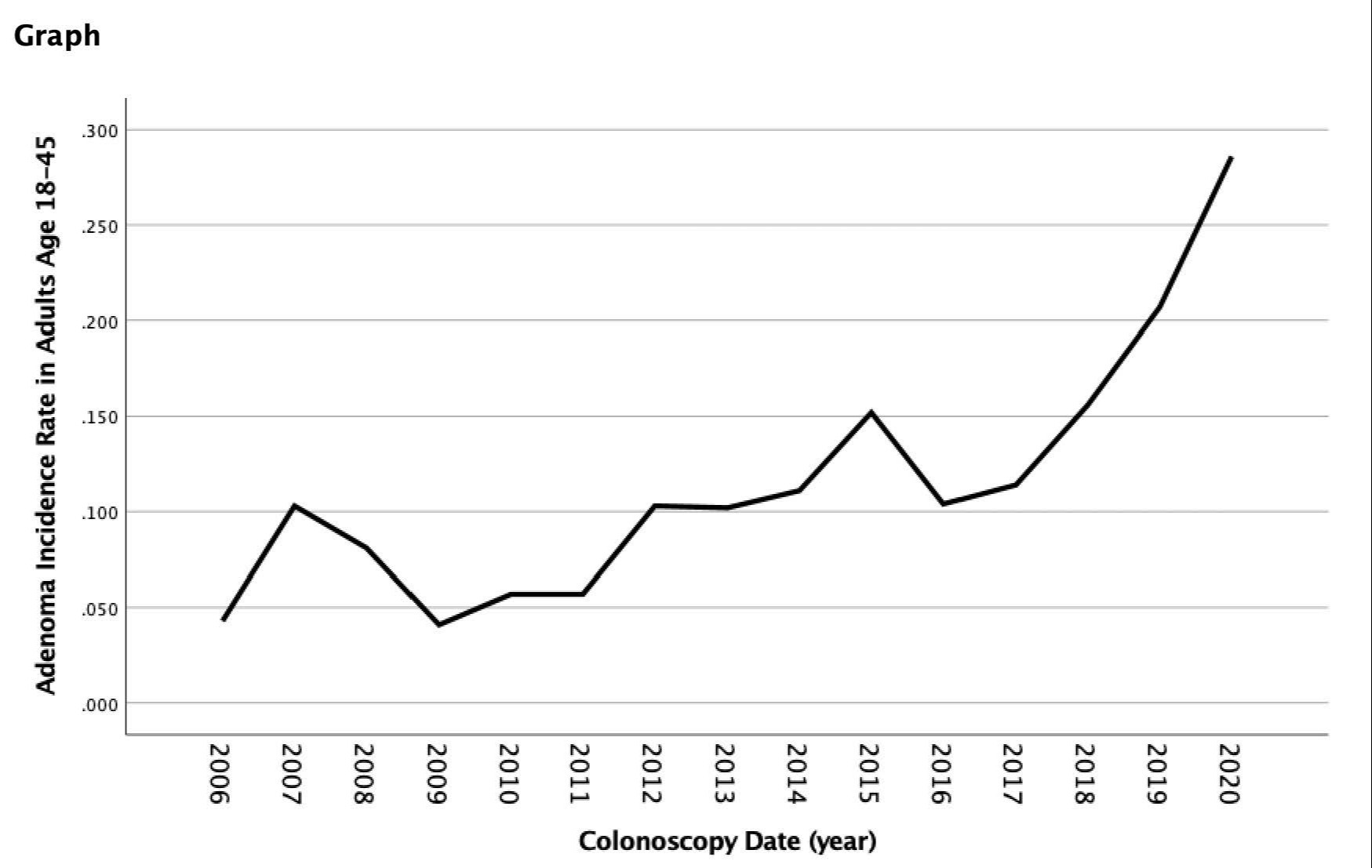Back


Poster Session D - Tuesday Morning
Category: Colon
D0090 - Incidence Rates of Adenoamtous Polyps, Clinically Significant Serrated Polyps and Advanced Neoplasia in Adults Age 18-45 in a Community Hospital in the Upper Midwest Over a 15-Year Period: A Retrospective Review
Tuesday, October 25, 2022
10:00 AM – 12:00 PM ET
Location: Crown Ballroom

Has Audio
- BG
Bailey Gifford, BS, BA
University of Minnesota - Duluth
Duluth, MN
Presenting Author(s)
Yonatan Hillman, MD1, Bailey Gifford, BS, BA2, William Sieling, MPH2, Casey Norton, BS2, Jewel Stone, 2, Bari Hillman, PhD3
1St. Luke's Hospital, Duluth, MN; 2University of Minnesota - Duluth, Duluth, MN; 3Yeshiva University, New York, NY
Introduction: Increasing incidence of early onset colorectal cancer over time has been well described. Temporal trends regarding precursor lesions in young adults are less clearly defined. The aim of this study was to investigate trends in the rates of adenomatous colon polyps, clinically significant serrated polyps and advanced neoplasia in young adults over a 15 year period.
Methods: We performed a retrospective review of all colonoscopy examinations performed in two community hospitals and an ambulatory surgery center in northern Minnesota between January 1, 2006 and December 31, 2020 in adults age 18-45. Exclusion criteria were incomplete colonoscopy exams or exams with inadequate bowel preparation. A total of 2655 colonoscopy exams were included in our review. We measured the incidence rates of adenomas, clinically significant serrated polyps (sessile serrated polyps, traditional serrated adenomas, proximal hyperplastic polyps > 4 mm and hyperplastic polyps > 9 mm) and rates of advanced neoplasia (adenoma > 9 mm, villous histology, high grade dysplasia, colon cancer) for each year in the study period. The relationship between time (as measured by year) and incidence of adenomatous polyps, clinically significant serrated polyps, advanced neoplasia and non-malignant advanced neoplasia was investigated using Spearman Rank Order Correlation (rho). Preliminary analyses were performed to ensure no violation of the assumptions.
Results: There were a total of 291 cases with at least one adenoma detected (11.0% incidence rate), 63 cases with at least one clinically significant serrated polyp (2.4% incidence rate), 60 cases with advanced neoplasia (2.3% incidence) and 8 cases of colorectal cancer (0.3% incidence rate). The incidence rate of adenomatous polyps increased over the course of the study period (rho = .88, n = 15, = p < .001). The incidence of clinically significant serrated polyps increased over the study period, however this finding was not statistically significant. The incidence of advanced neoplasia increased over the course of the study period and trended towards significance (rho = .50, n = 15, p = .056).
Discussion: Incidence rates of adenomatous colon polyps in young adults increased over the study period while rates of advanced neoplasia appeared to increase over the study period. More complete understanding of temporal trends in different precursor colon lesions in young adults may help guide endoscopists caring for young adults with lower GI symptoms.

Disclosures:
Yonatan Hillman, MD1, Bailey Gifford, BS, BA2, William Sieling, MPH2, Casey Norton, BS2, Jewel Stone, 2, Bari Hillman, PhD3. D0090 - Incidence Rates of Adenoamtous Polyps, Clinically Significant Serrated Polyps and Advanced Neoplasia in Adults Age 18-45 in a Community Hospital in the Upper Midwest Over a 15-Year Period: A Retrospective Review, ACG 2022 Annual Scientific Meeting Abstracts. Charlotte, NC: American College of Gastroenterology.
1St. Luke's Hospital, Duluth, MN; 2University of Minnesota - Duluth, Duluth, MN; 3Yeshiva University, New York, NY
Introduction: Increasing incidence of early onset colorectal cancer over time has been well described. Temporal trends regarding precursor lesions in young adults are less clearly defined. The aim of this study was to investigate trends in the rates of adenomatous colon polyps, clinically significant serrated polyps and advanced neoplasia in young adults over a 15 year period.
Methods: We performed a retrospective review of all colonoscopy examinations performed in two community hospitals and an ambulatory surgery center in northern Minnesota between January 1, 2006 and December 31, 2020 in adults age 18-45. Exclusion criteria were incomplete colonoscopy exams or exams with inadequate bowel preparation. A total of 2655 colonoscopy exams were included in our review. We measured the incidence rates of adenomas, clinically significant serrated polyps (sessile serrated polyps, traditional serrated adenomas, proximal hyperplastic polyps > 4 mm and hyperplastic polyps > 9 mm) and rates of advanced neoplasia (adenoma > 9 mm, villous histology, high grade dysplasia, colon cancer) for each year in the study period. The relationship between time (as measured by year) and incidence of adenomatous polyps, clinically significant serrated polyps, advanced neoplasia and non-malignant advanced neoplasia was investigated using Spearman Rank Order Correlation (rho). Preliminary analyses were performed to ensure no violation of the assumptions.
Results: There were a total of 291 cases with at least one adenoma detected (11.0% incidence rate), 63 cases with at least one clinically significant serrated polyp (2.4% incidence rate), 60 cases with advanced neoplasia (2.3% incidence) and 8 cases of colorectal cancer (0.3% incidence rate). The incidence rate of adenomatous polyps increased over the course of the study period (rho = .88, n = 15, = p < .001). The incidence of clinically significant serrated polyps increased over the study period, however this finding was not statistically significant. The incidence of advanced neoplasia increased over the course of the study period and trended towards significance (rho = .50, n = 15, p = .056).
Discussion: Incidence rates of adenomatous colon polyps in young adults increased over the study period while rates of advanced neoplasia appeared to increase over the study period. More complete understanding of temporal trends in different precursor colon lesions in young adults may help guide endoscopists caring for young adults with lower GI symptoms.

Figure: Incidence of adenomatous colon polyps in young adults over time.
Disclosures:
Yonatan Hillman indicated no relevant financial relationships.
Bailey Gifford indicated no relevant financial relationships.
William Sieling indicated no relevant financial relationships.
Casey Norton indicated no relevant financial relationships.
Jewel Stone indicated no relevant financial relationships.
Bari Hillman indicated no relevant financial relationships.
Yonatan Hillman, MD1, Bailey Gifford, BS, BA2, William Sieling, MPH2, Casey Norton, BS2, Jewel Stone, 2, Bari Hillman, PhD3. D0090 - Incidence Rates of Adenoamtous Polyps, Clinically Significant Serrated Polyps and Advanced Neoplasia in Adults Age 18-45 in a Community Hospital in the Upper Midwest Over a 15-Year Period: A Retrospective Review, ACG 2022 Annual Scientific Meeting Abstracts. Charlotte, NC: American College of Gastroenterology.
